60°- 30° right triangles
Three identical 30-60-90 right triangles are arranged as shown in the figure.
What is the ratio of the red segment’s length to the blue segment’s length?
The answer is 3.5.
This section requires Javascript.
You are seeing this because something didn't load right. We suggest you, (a) try
refreshing the page, (b) enabling javascript if it is disabled on your browser and,
finally, (c)
loading the
non-javascript version of this page
. We're sorry about the hassle.
9 solutions
Very efficient method, avoids trigonometry ....
Minor typo, in equation (1) the radical in the y-intercept should be root 3, not root 2. Got me all confused for a bit where the root 2 came from.
Log in to reply
Thanks, I've corrected it! Sorry for time you lost recalculating.
Relevant wiki: Cosine Rule (Law of Cosines)
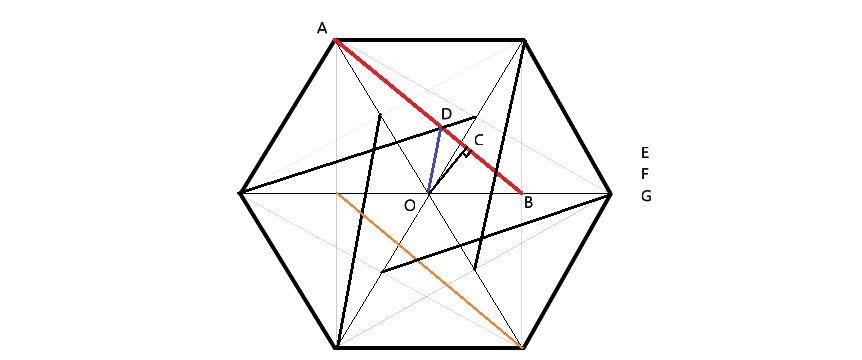
We expand the graph into a complete hexagon, and found that the six linked segment construct another smaller inside hexagon.
Let A O = 2 so then O B = 1 , using Law of Cosine obtain A B = 7 .
Using different area expressions of Δ A O B , yield
A O × O B sin 1 2 0 ∘ = A B × O C then get O C = 7 3 .
Let's observed closer at the smaller hexagon, we have O D cos 3 0 ∘ = O C and gives us O D = 7 2 .
Finally, the ratio of the red segment's length to the blue segment's length will be O D A B = 2 7 .
Wow, it is really interesting to notice how constructing the Hexagon makes the job much simpler.
Log in to reply
Ya, I knew using coordinate is intuitive, but I want to find a beautiful way to do this.
Why OB is 1? What is the relation with AO?
Log in to reply
It is a arbitrary value, I just let OA = 2 and OB = 1 base on the relationship of s i n 3 0 ∘ . Because question is asking about the ratio, so the values of OA and OB don't matter.
(my English is poor)
i use the axis to solve it ,may be using the geometric is more good)
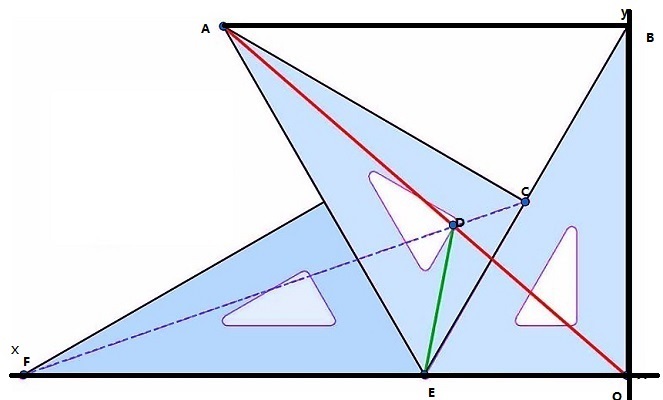
my method:
1:calculate AO (use AB and BO)
2:determine the equation of AO
3:determine the equation of DE
4:determine the coordinate of D and E
5: calculate the length of DE
END
|3 is the square root of 3
- assume EO=1 BO=|3
so AC=|3 EC=1
EB=2
so cb=1
∠ACB = 90
so AB=2 and ∠ABO=90
A(2,|3)
AO=|7
AO is y=
2
∣
3
x
C is the midpoint of EB
C (
2
1
,
2
∣
3
)
F(3,0)
so FC is y=-
5
∣
3
x +
5
3
3
then D (
7
6
,
7
3
∣
3
)
DE=
5
2
∣
7
the Ans is 3.5
Interesting problem. I have used similar method, but made silly mistakes.Here my solutions: We can solve the problem by coordinate geometry
Let the origin is at the point E(0,0).Wlog let the triangle has sides of 1,√3,2. So the coordinates of point O(1,0), B(1,√3), C(1/2,1/2 √3),A(-1, √3), and F(-2,0). The equations of line CF: y=√3/5 (x- 2), AO: y = -√3/2 (x- 1), So we can find the intersection point of these two lines (1/7 , 3√3/7) So the ratio of the red line to the green line is 7√7/√28 = 3.5
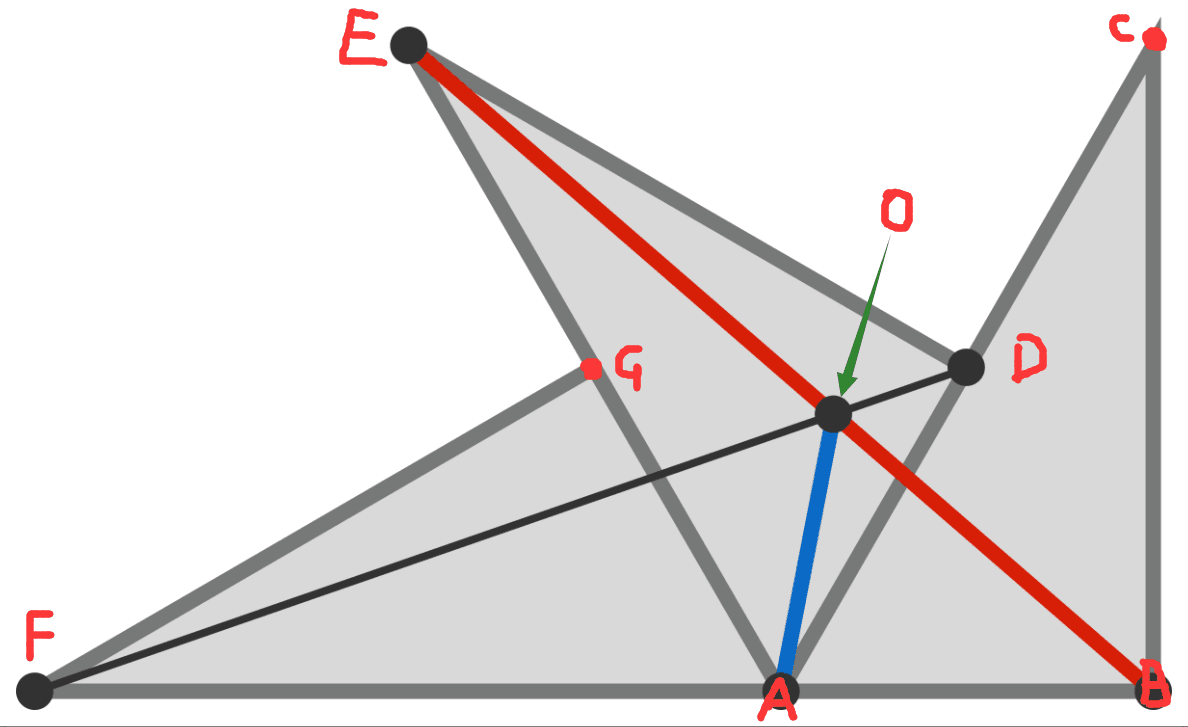 We can prove that △BOF is similar to △AOE and △DOA.
So the ratio of OB to OA is the same as the ratio of BF to AE, which is actually 3:2.
Also, the ratio of OA to OE is the same as the ratio of AD to AE, which is actually 2:1.
So, the ratio of BE and OA is 3.5
We can prove that △BOF is similar to △AOE and △DOA.
So the ratio of OB to OA is the same as the ratio of BF to AE, which is actually 3:2.
Also, the ratio of OA to OE is the same as the ratio of AD to AE, which is actually 2:1.
So, the ratio of BE and OA is 3.5
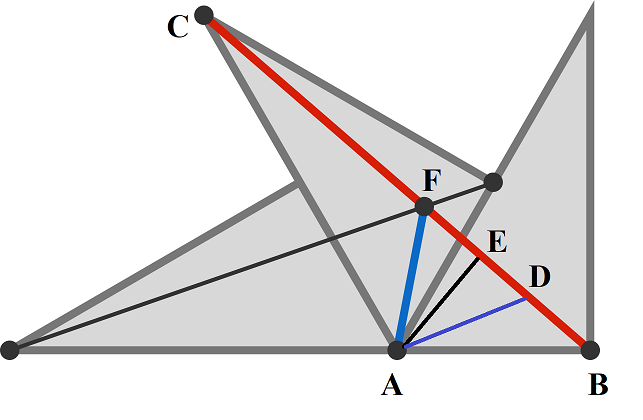
Denote a = A B , b = B C , c = A F , h = A E . There follows A C = 2 a , ∠ C A B = 3 2 π . Applying the cosine theorem, we find b = a 7 . Denote s = 2 a + 2 a + b = 2 a ( 3 + 7 ) and apply Heron's formula to find the area of Δ A B C , obtaining 2 a 2 3 . On the other hand the area of Δ A B C is 2 b h = 2 a h 7 , so h = a 7 3 . Taking into account that the triangle A D F is equilateral, with c = A F = A D = D F , and its area is 4 c 2 3 = 2 c h = 2 c a 7 3 . So c = 7 2 a , and the required ratio is c b = 7 2 a a 7 = 2 7 = 3 . 5 .
Why is triangle ADF equilateral?
Log in to reply
I expected such a question! On the segment B C we determine the point D , so that A F = A D . The rotation of the triangle on the right side around A is by the angle of 3 π , whereby A D maps into A F , accordingly F D = A F = A D .
Sorry,I'm just not good at English.So I decided to draw a picture to show the solution.
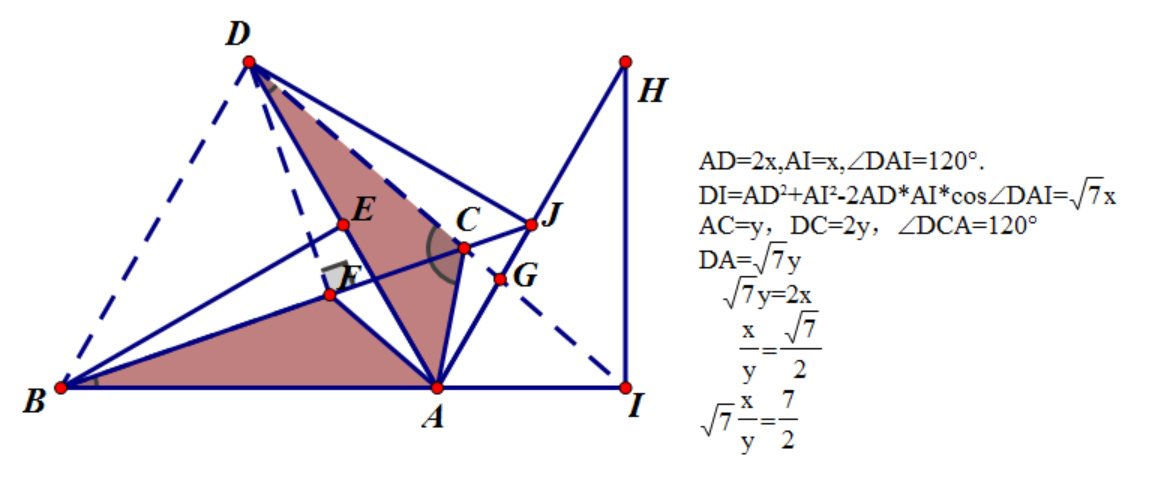
TLDR;
R = 2 . 5 2 + 2 3 2 = 7
Δ A E C s i m i l a r Δ A C D
2 7 ∗ 1 7 = 3 . 5
I thought this was a rather elegant solution, but I could not find a way to prove Δ A E C is similar to Δ A C D in a simple way

- Since all three 30-60-90 triangles are the same the red line is the same as the black line. Δ A E C = Δ F B C
- The triangle ABC we know because it is a 30-60-90 triangle its sides are A B = 3 , A C = 2 , and B C = 1 (or any multiple) segment B C = 1 and segment G C = 2 . We know B C is half way between segment C E and segment G E so the dimensions of Δ B F H are 2 . 5 , 3 / 2
- Solve for the black and red line Δ A E C = Δ F B C R = 2 . 5 2 + 2 3 2 = 7 Now we know Δ A E C 's sides A C = 2 , C E = 1 , A E = 7
- We can determine Δ A E C is similar to Δ A C D Recognizing ∠ F D E is the interior angle of a regular hexagon ∠ F D E = 1 2 0 ToDo (please help)
- Given Δ A E C is similar to Δ A C D we set up the proportion of the larger triangle A E to the smaller triangle A C and the proportion of the longest side A E to the shortest side C E .
2 7 ∗ 1 7 = 3 . 5
open autocad on your computer, draw 30 60 triangle, copy it and rotate 60 degrees, draw the additional needed lines and get thier, dimentions, after dividing them by each other you will get the ratio 3.5:1 ... No clapping. Thank you.
You could do the same with Geogebra too, right?
Wouldn't it be easier to just get a ruler and measure the ratio of the 2 lines on your screen directly?
Log in to reply
I measured with my fingers and guessed right on the second try.
the blue segment can be seen a side of the equilateral triangle that lies on the red segment
R l e n g t h = 2 2 + 3 2 = 7 Set up the equations: ( 1 ) y = − 2 3 x + 2 3 3 ( 2 ) y = 5 3 x . Find the point of intersection: ( 5 3 + 2 3 ) x 1 0 7 3 x 5 7 x x ⟹ y = 2 3 3 = 2 3 3 = 3 = 7 1 5 = 7 3 3 . Now, you have: B l e n g t h = ( 7 1 5 − 2 ) 2 + ( 7 3 3 ) 2 = 4 9 2 8 = 7 2 7 . Hence, B l e n g t h R l e n g t h = 7 2 7 7 = 2 7 = 3 . 5 .